The action was unpredictable, very fast-paced, and most exciting when I was surrounded by the concentration of Bald Eagles that appeared without precedence at the rather circular frozen lake 7 miles north of my office. At times a dozen eagles were in the air before me, while others were perched in adjacent trees – providing multiple photo opportunities, usually requiring me to pick one bird, most often the closest eagle, sometimes the one with the most interesting plumage patterns.
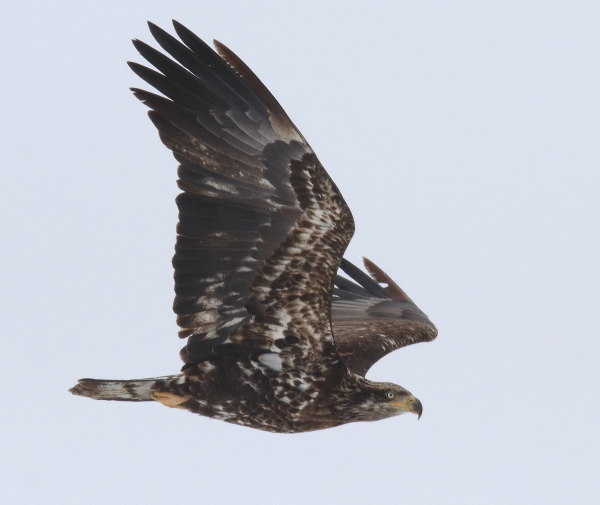
Among the average of 90 Bald Eagles that assembled on the ice and within a mile or so of the lake, the adults showed little variation, but the young eagles, ranging from 1 to 4 years of age showed considerable variation, mostly age related and more a consequence of the pre-adult plumage molts. Because eagles don’t molt their feathers at once, even within a given age group, there are varied color combinations of brown and white among the body plumage, and the feathers of the wings and tail – making for an exciting level of variations between age groups and individuals within each age cohort.
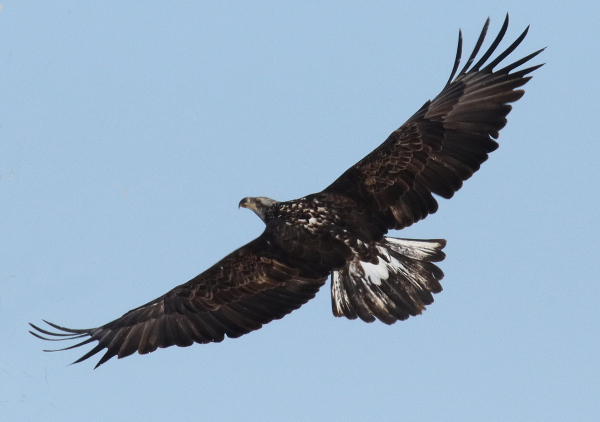
This variation also adds to the interest levels while photographing, or trying to photograph the eagles as the winged by with surprising speed. It would have been much easier to photograph soaring eagles, but the intense wind after the snow ended made trying to photograph the birds in action all the more testing and exciting. An eagle gliding on the wind might suddenly lift a wing to change the direction of its flight, making trying to get a focus on it much harder, and it was often tough to even keep an eagle within the photo frame at times. I tried my best to swing my camera and lens combo with a like speed and direction to follow the eagle’s zooming flight and the effort was exhilarating time and time again.
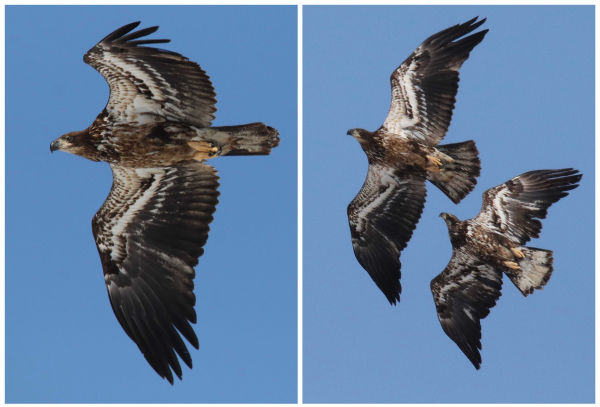
The Initial Waiting Game
While completing my first survey of the unprecedented concentration of Bald Eagles, the wind began blowing the first big flakes of snow as winter warned it may not have receded from the Northern Plains. For 2 days after Saturday’s count totaled an almost unbelievable 166 Bald Eagles in the area, it was pointless to even try to photograph among the eagles, and the few documentary photos I did take showed distant eagles partly obscured by blowing snow. But knowing that was bound to change, I hoped the eagles would remain in the area. After all, with a 30 mile per hour north wind blowing, how would a large broad-winged eagle choose to try to press farther north.
By late afternoon Monday, there was a scant promise that some sunlight might break through the white shroud of clouds, even though the wind remained intense. But the wind proved to be a plus as it seemed to keep the eagles more active, and as they used the wind, fought the wind, and seemed to play in the wind at times. I found myself being in position to take several series of photos of individuals in flight, and even a few images that fit 2 or 3 eagles into the same frame. Although the sun didn’t break through, the bright subdued afternoon light was ample enough to illuminate eagles and provide fast shutter speeds to stop the action of eagle flights using an ISO of 800.

Tuesday broke with a similar fairly uniform cloud cover, but about 1pm the waiting game was over as the sun broke through and provided the best illumination since the previous Friday. The wind was still howling, but the eagles remained activated and yielded several fine photo ops when I could break away from work for an hour during a busy publishing day. One thing I realized during the 2 afternoon photo periods was that there was a reflective quality to the 2 inches of new snow cover. While the sunlight illuminated the birds from an elevated position behind me, there was a secondary reflected light that apparently was bouncing off the snow to add light from below.
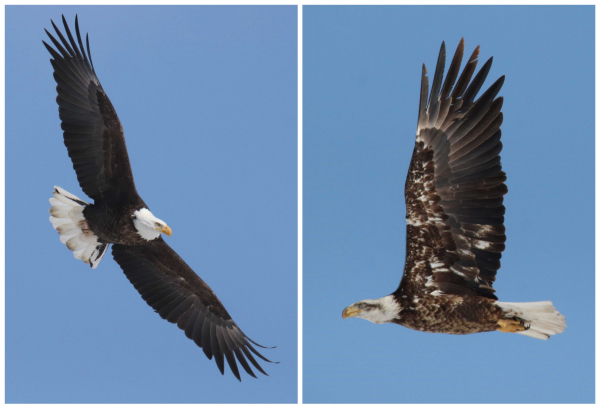
I have seen this affect in other photos I’ve taken in the past, but wasn’t sure what to attribute that highlighted lighting to. Tuesday it became crystal clear, and I appreciated chances to photograph eagles, geese, and ducks in the primo lighting conditions. With The Birding Wire secure in your email boxes Wednesday morning, I was free to spend some extra time afield with clear sunlight and a greatly reduced wind, along with more snow-reflected light from below, but it became more and more evident that something changed among the eagles.
There were still more than 60 Bald Eagles in plain sight, but they just weren’t as animated, they didn’t approach my positions, and that changed everything from a photography standpoint. I brushed it off as a stand alone episode, but a return trip during the afternoon proved to be a second slump. Thursday’s eagle total doubled north of home, and the wind died down as the sun remained, but the eagles just weren’t very active in areas that I could access. They were present but they tended to remain perched in the shelter of tree branches, or beyond the magnification stretch of my zoom lens.
Since then I’m waiting for the sunlight to cast its beautiful glow on the area again, but while the eagle numbers see-saw up and down between 55 and 120, the eagles aren’t as giving or as active as they were the Monday and Tuesday before. So let me review those days and the photos I so enjoyed taking, with one eagle after another passing overhead before me, banking in the wind and twisting this way and that, showing their plumage in detail, feather by feather, patterns and colors and shades of coloration. Slipping into focus, then out, then back into sight again; turning into the sun, gliding on the wind, and every once in a while, looking my way.
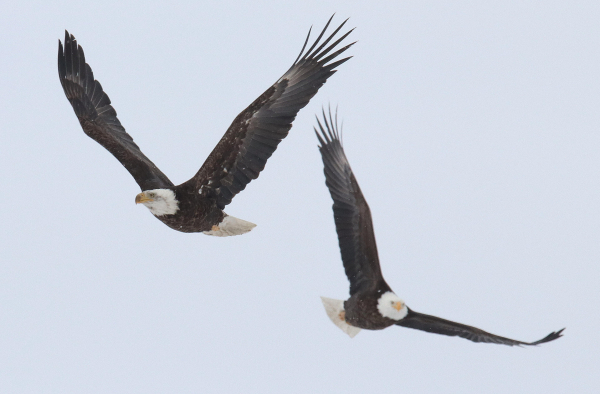
The abruptness of the appearance of Bald Eagles that provided most photo ops coupled with the speed at which their flights took place kept the excitement level high during the quick moments I had to react, get the eagle in my camera frame, focus on the bird – even using auto-focus – then following its flashing flight; it was a thrill each time it happened! In cases like that, I find myself being something of a photo thrill seeker, and the eagles fulfilled that feeling time and time again Monday and Tuesday with me wanting more and more. What Fun!
As you read this, there are still an average of about 90 Bald Eagles on hand, and I hope for more photos each time I drive 7 miles north – thrill me again big birds, give me more eagle excitement!
Article and photographs by Paul Konrad
Share your bird photos and birding experiences at editorstbw2@gmail.com